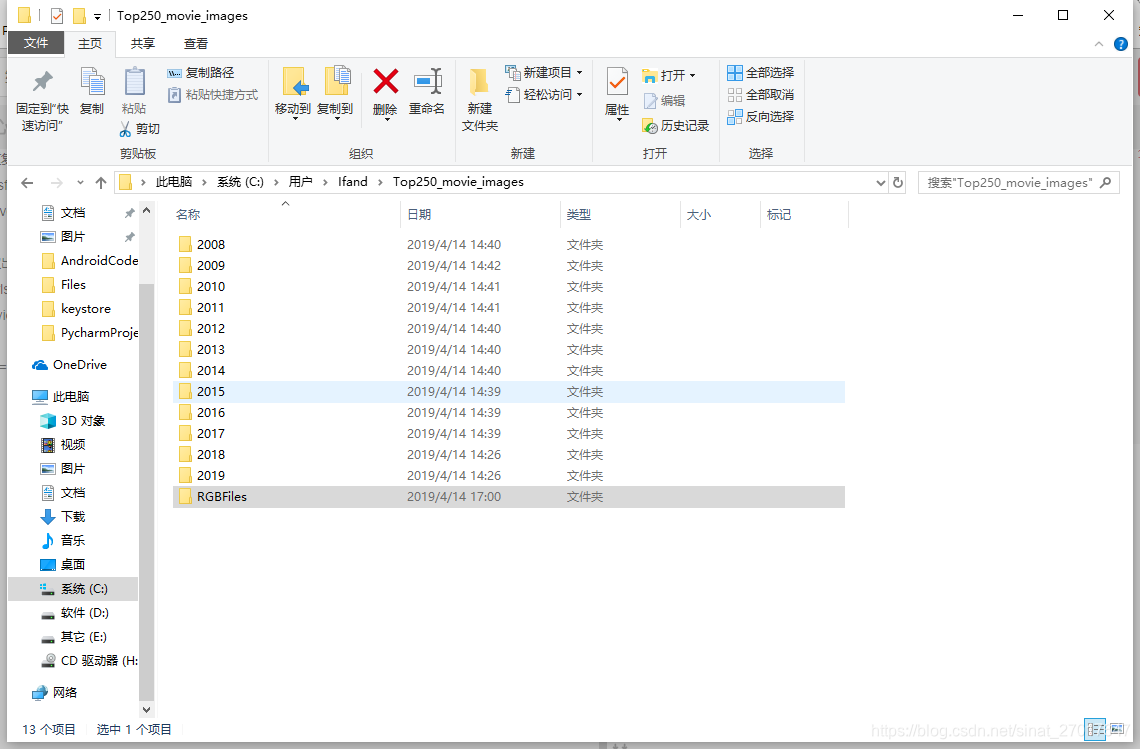作业一:编程设计电影海报的色彩
作业一:设计电影海报的色彩可视化作品。模仿课程PPT第四章第43页上的1914年以来电影海报的颜色做进行可视化的作品,设计实现中国从2008年到2018年这十年间的国产电影海报的颜色可视化作品。具体要求如下:
- 采用Python语言编写从互联网上去获取自2008年-2018年中国国产电影的宣传海报图片的爬虫程序,并按年度分类存储;
- 针对这些图片,获取每幅图片上的每个像素的色彩值;
- 统计每幅海报图片中出现的像素颜色值数据;
- 纵坐标方向自上往下表示从2008年到2018年,横坐标表示当年电影海报中所包含的色彩(简单地以7色光为统计单位)
- 按自左至右红橙黄绿青蓝紫的顺序
- 对该作品进行一下感知和认知层面上的分析和解读
- 按本章课程PPT第四页的一般性流程,描述作品完成的过程及撰写体会
一、使用Python爬取1905网站的数据
此代码使用了zhaoolee写的爬取豆瓣TOP250的代码《进击的虫师》爬取豆瓣电影海报(Top250)
我在此基础上加了一点来实现老师的需求
import os
import requests
from lxml import etree
import re
# 负责下载电影海报
def download_img(title, img_addr, headers, time):
# 如果不存在图片文件夹,则自动创建
if os.path.exists("./Top250_movie_images/"):
pass
else:
os.makedirs("./Top250_movie_images/")
if os.path.exists("./Top250_movie_images/" + time + "/"):
pass
else:
os.makedirs("./Top250_movie_images/" + time + "/")
# 获取图片二进制数据
image_data = requests.get(img_addr, headers=headers).content
# 设置海报存存储的路径和名称
image_path = "./Top250_movie_images/" + time + "/" + title[0] + '.jpg'
# 存储海报图片
with open(image_path, "wb+") as f:
f.write(image_data)
# 根据url获取数据,并打印到屏幕上,并保存为文件
def get_movies_data(url, headers):
# 获取页面的响应内容
db_response = requests.get(url, headers=headers)
# 将获得的源码转换为etree
db_reponse_etree = etree.HTML(db_response.content)
# 提取所有电影数据
db_movie_items = db_reponse_etree.xpath('//*[@class="fl line"]/a')
print(len(db_movie_items))
# 遍历电影数据列表,
for db_movie_item in db_movie_items:
# 这里用到了xpath的知识
db_title = db_movie_item.xpath('img/@alt')
print(db_title)
db_date = db_movie_item.xpath('img/@data-original')
db_img_addr = db_movie_item.xpath('img/@src')
word = 'uploadfile'
index = [m.start() + 11 for m in re.finditer(word, str(db_date[0]))]
print(index)
db_movie_date = db_date[0][index[0]:index[0]+4]
print("标题:", db_title[0]+" 时间:", db_movie_date + " URL:", db_date[0])
# a表示追加模式, b表示以二进制方式写入, + 表示如果文件不存在则自动创建
with open("./douban_movie_top250.txt", "ab+") as f:
tmp_data = "标题:"+str(db_title)+ "-" + str(db_movie_date) + "\n"
f.write(tmp_data.encode("utf-8"))
db_img_addr = str(db_img_addr[0].replace("\'", ""))
download_img(db_title, db_img_addr, headers, str(db_movie_date))
def main():
# 使用列表生成式,生成待爬取的页面url的列表
urls = []
for i in range(5, 107):
urls.append("http://www.1905.com/mdb/film/list/country-China/o0d0p"+str(i)+".html")
# urls = ["[图片]http://www.1905.com/mdb/film/list/country-China/o0d0p"+str(i*1) for i in range(5,108)+".html"]
# 设置请求头
headers = {
# 设置用户代理头
"User-Agent": "Mozilla/5.0 (Macintosh; Intel Mac OS X 10_12_6) AppleWebKit/537.36 (KHTML, like Gecko) Chrome/63.0.3239.132 Safari/537.36",
}
# 为避免重复运行程序,造成内容重复,这里把上次的文件清除(可跳过)
if os.path.isfile("./douban_movie_top250.txt"):
os.remove("./douban_movie_top250.txt")
# 从列表取出url进行爬取
for url in urls:
get_movies_data(url, headers)
if __name__ == '__main__':
main()

二、针对这些图片,获取每幅图片上的每个像素的色彩值
- 使用list_all_files(’./Top250_movie_images’)遍历生成的海报
- 导入from PIL import Image并使用toRGB(name)对于每一张海报都生成对应的色彩值
- 使用data_write_csv(file_name, datas)或text_save(filename, data)生成对应的文件
from PIL import Image
import numpy
import csv
import codecs
import os
import re
def data_write_csv(file_name, datas): # file_name为写入CSV文件的路径,datas为要写入数据列表
file_csv = codecs.open(file_name, 'w+', 'utf-8') # 追加
writer = csv.writer(file_csv, delimiter=' ',
quotechar=' ', quoting=csv.QUOTE_MINIMAL)
for data in datas:
writer.writerow(data)
print("保存文件成功,处理结束")
def text_save(filename, data): # filename为写入CSV文件的路径,data为要写入数据列表.
file = open(filename, 'a')
for i in range(len(data)):
s = str(data[i]).replace(
'[', '').replace(']', '') # 去除[],这两行按数据不同,可以选择
s = s.replace("'", '').replace(',', '') + '\n' # 去除单引号,逗号,每行末尾追加换行符
file.write(s)
file.close()
print("保存文件成功")
def list_all_files(rootdir):
import os
_files = []
list = os.listdir(rootdir) # 列出文件夹下所有的目录与文件
for i in range(0, len(list)):
path = os.path.join(rootdir, list[i])
if os.path.isdir(path):
_files.extend(list_all_files(path))
if os.path.isfile(path):
_files.append(path)
print(path)
name = path[22:]
toRGB(name)
# print(name)
return _files
def toRGB(name):
time = name[:4]
title = name[5:-4]
print(title + " " + time)
img = Image.open("C:\\Users\\Ifand\\Top250_movie_images\\" + name)
img_array = img.load()
width, height = img.size
all_pixels = []
for x in range(width):
for y in range(height):
cpixel = img_array[x, y]
all_pixels.append(cpixel)
# print(img_array[6, 4])
print(len(all_pixels))
# 如果不存在文件夹,则自动创建
if os.path.exists("./Top250_movie_images/RGBFiles"):
pass
else:
os.makedirs("./Top250_movie_images/RGBFiles")
if os.path.exists("./Top250_movie_images/RGBFiles/" + time + "/"):
pass
else:
os.makedirs("./Top250_movie_images/RGBFiles/" + time + "/")
# data_write_csv("./Top250_movie_images/RGBFiles/" + time + "/" + title + ".csv", all_pixels)
text_save("./Top250_movie_images/RGBFiles/" + time + "/" + title + ".txt", all_pixels)
def main():
_fs = list_all_files('./Top250_movie_images')
print(len(_fs))
if __name__ == '__main__':
main()

未完待续
作业地址(GitHub)